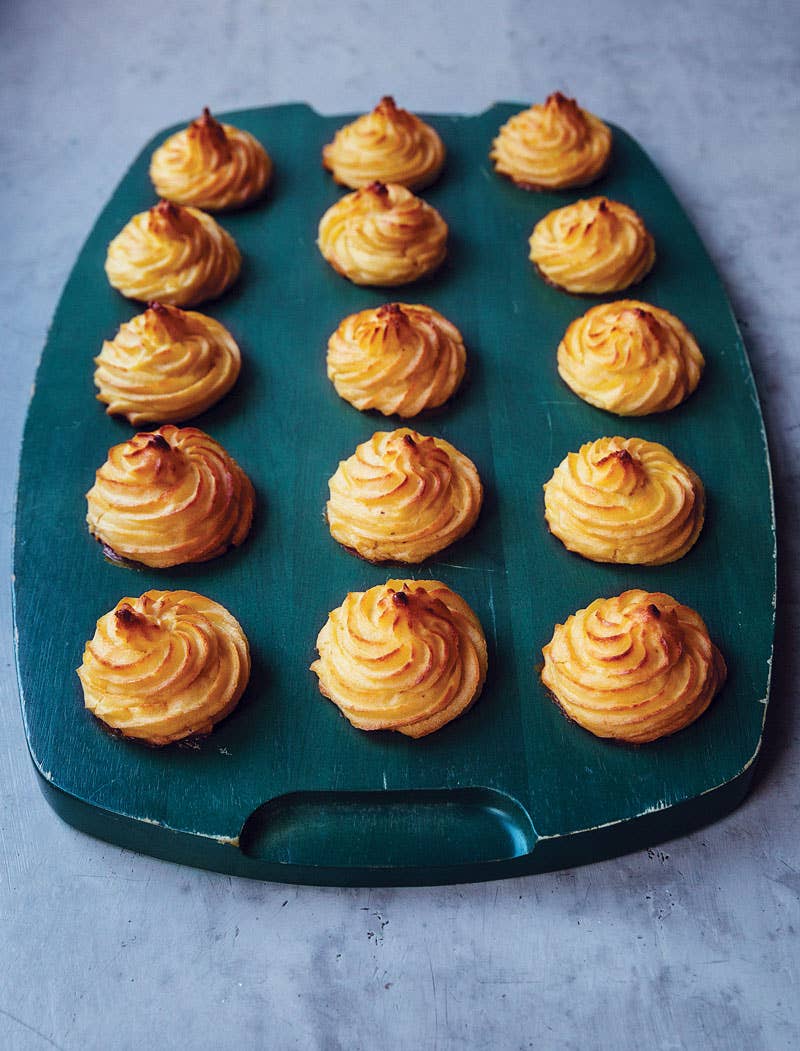
Ahab had his white whale. I had my pommes duchesse.
Hunched over a pastry bag in my Manhattan kitchen, my wrist cocked at a bizarre angle, I was about to give up on the classic French potato dish. Allegedly, it's simple to prepare: I'd roasted russet potatoes until they were tender, passed them through a ricer, and enriched the mash with egg yolks, butter, and a sprinkling of nutmeg. Now all I had to do was pipe the potatoes onto a sheet tray in the form of rosettes and bake them until golden brown.
The problem was in the piping. I wanted each swirl of pommes duchesse to resemble the grand, spiraling domes of St. Basil's Cathedral. Instead, I got a sad worm. Next, a button. On my third try, I hit an air bubble and the bag emitted a sound not suitable for sophisticated company.
When I was in culinary school, we'd devoted a full unit to the légume de résistance of the French table. I learned not only how to mash the potato, but how to transform it into pommes Anna, the slices layered and crisped in clarified butter, and luxurious gratin dauphinois, rounds smothered in cream and bubbling cheese. I even once successfully made pommes soufflés, technique-heavy, twice-fried chips that balloon into airy puffs when executed correctly. But one preparation, pommes duchesse, still remained out of my reach.
It was a signal of haute cuisine, the hottest potato accompaniment of the 1960s and '70s, spanning the globe and gracing everything from plates of chateaubriand in New York steakhouses to the scallop shells of Paris atop coquilles St-Jacques. I knew that if I really wanted to master the French potato canon, I had to nail pommes duchesse.
So like any good procrastinator, I took a break and hit the library. How had my nemesis come to be a Gallic cooking class requisite anyway? Before the fall of the Bastille, I learned, the monarchy wasn't the only entity in need of a public relations overhaul: Potatoes weren't doing so hot either. Though the South American tubers had landed in Europe a century prior, the French were so suspicious of potatoes that in 1748 the government issued a decree forbidding anyone to grow them; rumor had it they caused leprosy, sacrebleu!
Potato recipes didn't appear in cookbooks until Antoine-Auguste Parmentier, a former army pharmacist who had survived on little else while in captivity in Prussia during the Seven Years' War, made a pommes de terre public relations push as famine descended on 18th-century France. In 1817 a recipe for pommes duchesse finally appeared in a French cookbook, La Nouvelle Cuisinière Bourgeoise. Though a handful of people have tried to identify the aristocrat who lent her title to the dish, chances are there was no tuber-enamored duchess. In an effort to scrub potatoes of their bad reputation, 19th-century chefs created and named potato dishes generously, and "à la duchesse" ascribed a grandness to potatoes: This was an elevated tater, worthy of a royal.
I discovered that, for years, pommes duchesse referred primarily to croquettes—neat cylinders of puréed potatoes breaded and fried until crispy, no piping required. At the turn of the 20th century, Auguste Escoffier called for the potato mixture to be piped out as a border for cod gratin but not specifically as rosettes. And as late as the 1960s, Julia Child allowed for pommes duchesse to be shaped with a fork or spoon, though she warned that "they look far more stylish when squeezed through a pastry bag."
I wanted pommes duchesse with style, so I got on the phone with Jean François Bruel, executive chef at Manhattan's Daniel, one of the few restaurants that still serves the old-school side dish, to get a few tips on piping. It turns out that the technique dates back to 13th-century b.c. Mesopotamia; by the Middle Ages, it had traveled to Europe, where cooks piped forcemeat into pig stomachs and decorated them with slivered almonds to form elaborate, edible hedgehogs. If chefs of yore could pipe out spiny mammals, I figured my white whale was within reach.
According to Bruel, piping was simple: He told me to smoosh the riced potato mixture to one corner of the bag, compressing it to squeeze out any air bubbles. Then, holding it at an 80-degree angle, I was to exert slow, steady pressure from the top with one hand while guiding the flow of the mixture with the other. Once I learned the movement, there was structural integrity to consider. I had to build each rosette in tight concentric circles, leaving no hollow space inside, or the form I'd worked so hard to master would collapse in the oven.
I gave it another shot. My sheet tray looked a bit like an Evolution of Man chart, rendered in pommes purée. With each try, my potatoes rose further off their haunches until the last ones stood tall and handsome. After a brush of egg yolk and cream to ensure golden brown tops after baking, I slid them into the oven and waited.
Forty-five minutes later, the comforting smell of buttery potatoes hanging in the air, I assessed my work. Each pommes duchesse looked majestic, even the slightly deflated ones. I took a bite. A crunchy exterior gave way to a fluffy inside, with just a hint of warm baking spice from the nutmeg, like an über-dignified tater tot. After I'd polished off my third perfect swirl, I sat at my kitchen table smug, happy, and full—an Ahab no more.
Keep Reading
Continue to Next Story










